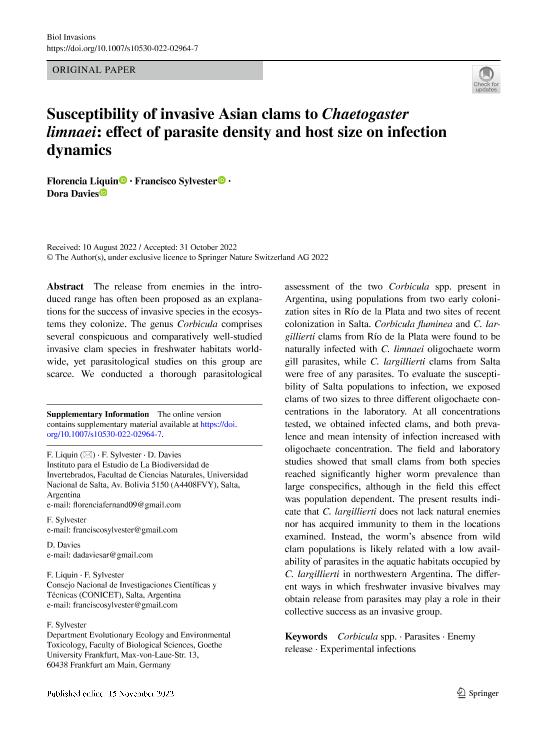Mostrar el registro sencillo del ítem
dc.contributor.author
Liquin, Florencia Fernanda

dc.contributor.author
Sylvester, Francisco

dc.contributor.author
Davies, Dora Ana

dc.date.available
2023-10-24T17:45:01Z
dc.date.issued
2022-11
dc.identifier.citation
Liquin, Florencia Fernanda; Sylvester, Francisco; Davies, Dora Ana; Susceptibility of invasive Asian clams to Chaetogaster limnaei: effect of parasite density and host size on infection dynamics; Springer; Biological Invasions; 25; 4; 11-2022; 1087-1099
dc.identifier.issn
1387-3547
dc.identifier.uri
http://hdl.handle.net/11336/215781
dc.description.abstract
The release from enemies in the introduced range has often been proposed as an explanations for the success of invasive species in the ecosystems they colonize. The genus Corbicula comprises several conspicuous and comparatively well-studied invasive clam species in freshwater habitats worldwide, yet parasitological studies on this group are scarce. We conducted a thorough parasitological assessment of the two Corbicula spp. present in Argentina, using populations from two early colonization sites in Río de la Plata and two sites of recent colonization in Salta. Corbicula fluminea and C. largillierti clams from Río de la Plata were found to be naturally infected with C. limnaei oligochaete worm gill parasites, while C. largillierti clams from Salta were free of any parasites. To evaluate the susceptibility of Salta populations to infection, we exposed clams of two sizes to three different oligochaete concentrations in the laboratory. At all concentrations tested, we obtained infected clams, and both prevalence and mean intensity of infection increased with oligochaete concentration. The field and laboratory studies showed that small clams from both species reached significantly higher worm prevalence than large conspecifics, although in the field this effect was population dependent. The present results indicate that C. largillierti does not lack natural enemies nor has acquired immunity to them in the locations examined. Instead, the worm's absence from wild clam populations is likely related with a low availability of parasites in the aquatic habitats occupied by C. largillierti in northwestern Argentina. The different ways in which freshwater invasive bivalves may obtain release from parasites may play a role in their collective success as an invasive group.
dc.format
application/pdf
dc.language.iso
eng
dc.publisher
Springer

dc.rights
info:eu-repo/semantics/openAccess
dc.rights.uri
https://creativecommons.org/licenses/by-nc-sa/2.5/ar/
dc.subject
CORBICULA SPP
dc.subject
ENEMY RELEASE
dc.subject
EXPERIMENTAL INFECTIONS
dc.subject
PARASITES
dc.subject.classification
Ecología

dc.subject.classification
Ciencias Biológicas

dc.subject.classification
CIENCIAS NATURALES Y EXACTAS

dc.title
Susceptibility of invasive Asian clams to Chaetogaster limnaei: effect of parasite density and host size on infection dynamics
dc.type
info:eu-repo/semantics/article
dc.type
info:ar-repo/semantics/artículo
dc.type
info:eu-repo/semantics/publishedVersion
dc.date.updated
2023-10-23T17:48:07Z
dc.journal.volume
25
dc.journal.number
4
dc.journal.pagination
1087-1099
dc.journal.pais
Alemania

dc.description.fil
Fil: Liquin, Florencia Fernanda. Consejo Nacional de Investigaciones Científicas y Técnicas; Argentina. Universidad Nacional de Salta. Facultad de Ciencias Naturales. Instituto para el Estudio de la Biodiversidad de Invertebrados; Argentina
dc.description.fil
Fil: Sylvester, Francisco. Goethe Universitat Frankfurt; Alemania. Consejo Nacional de Investigaciones Científicas y Técnicas; Argentina. Universidad Nacional de Salta. Facultad de Ciencias Naturales. Instituto para el Estudio de la Biodiversidad de Invertebrados; Argentina
dc.description.fil
Fil: Davies, Dora Ana. Universidad Nacional de Salta; Argentina
dc.journal.title
Biological Invasions

dc.relation.alternativeid
info:eu-repo/semantics/altIdentifier/doi/http://dx.doi.org/10.1007/s10530-022-02964-7
Archivos asociados
